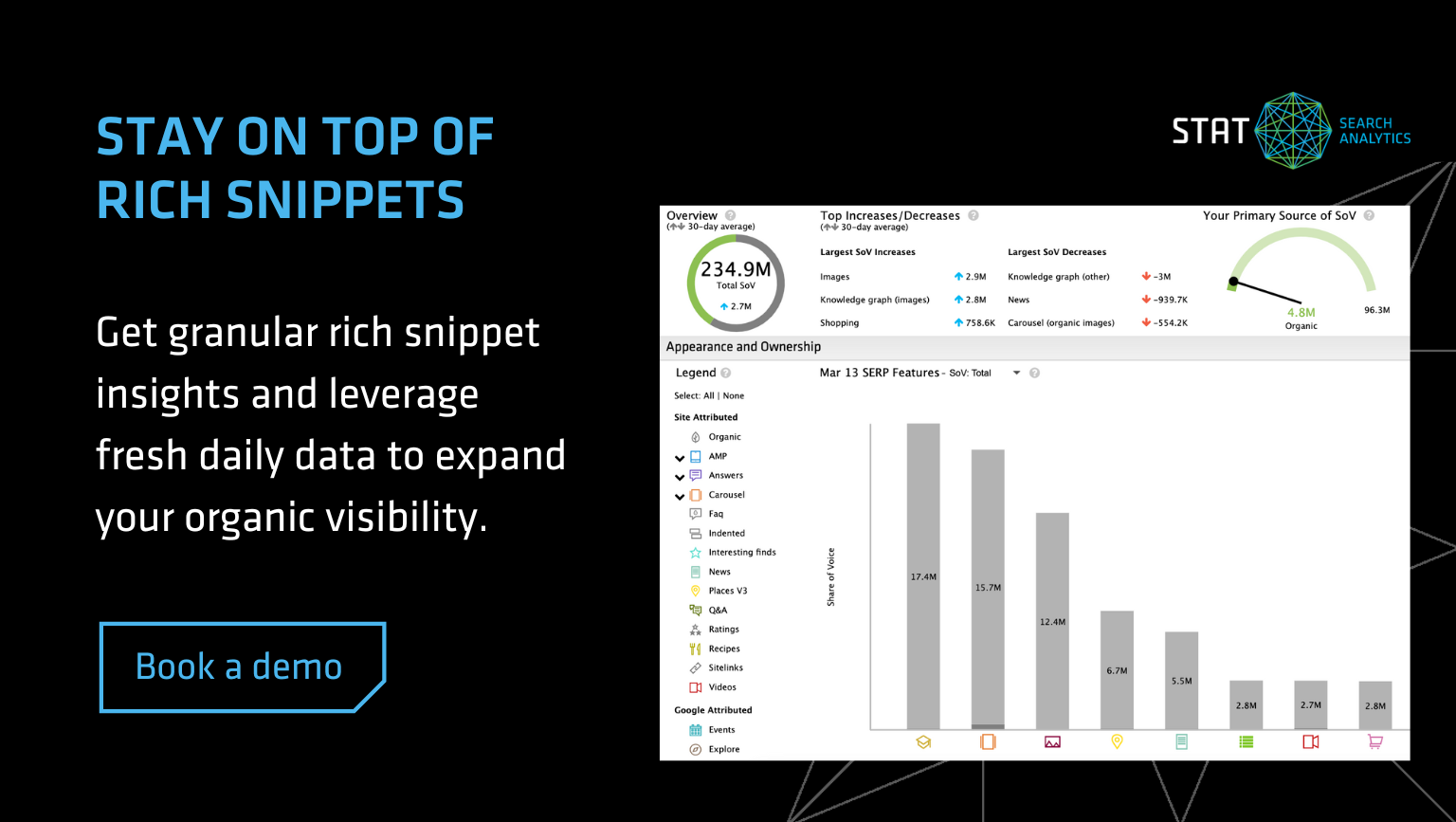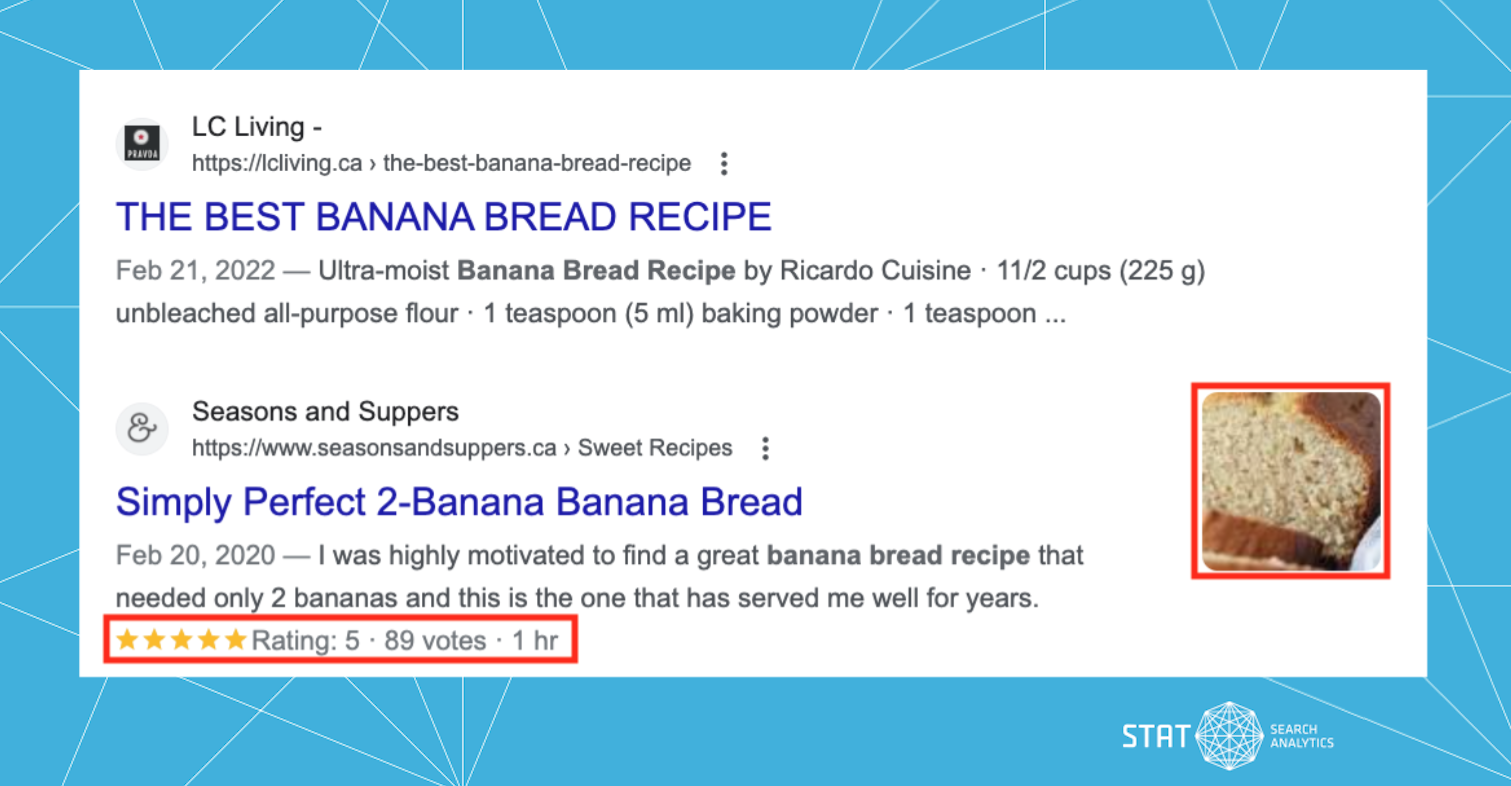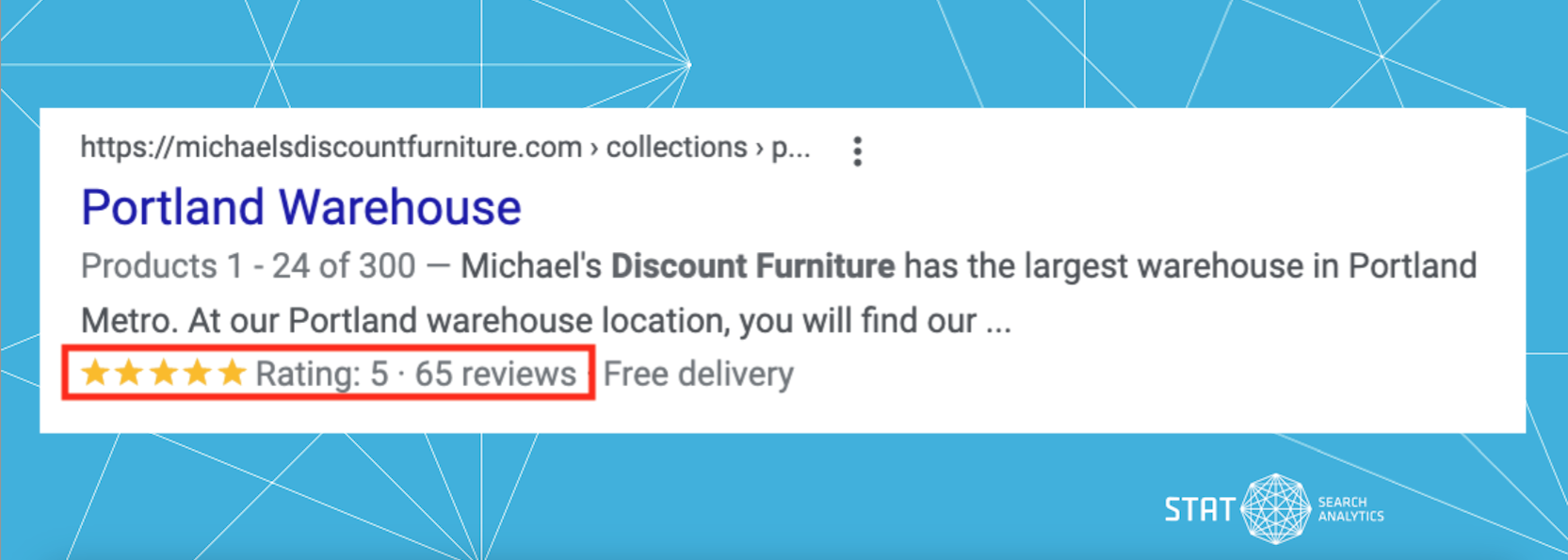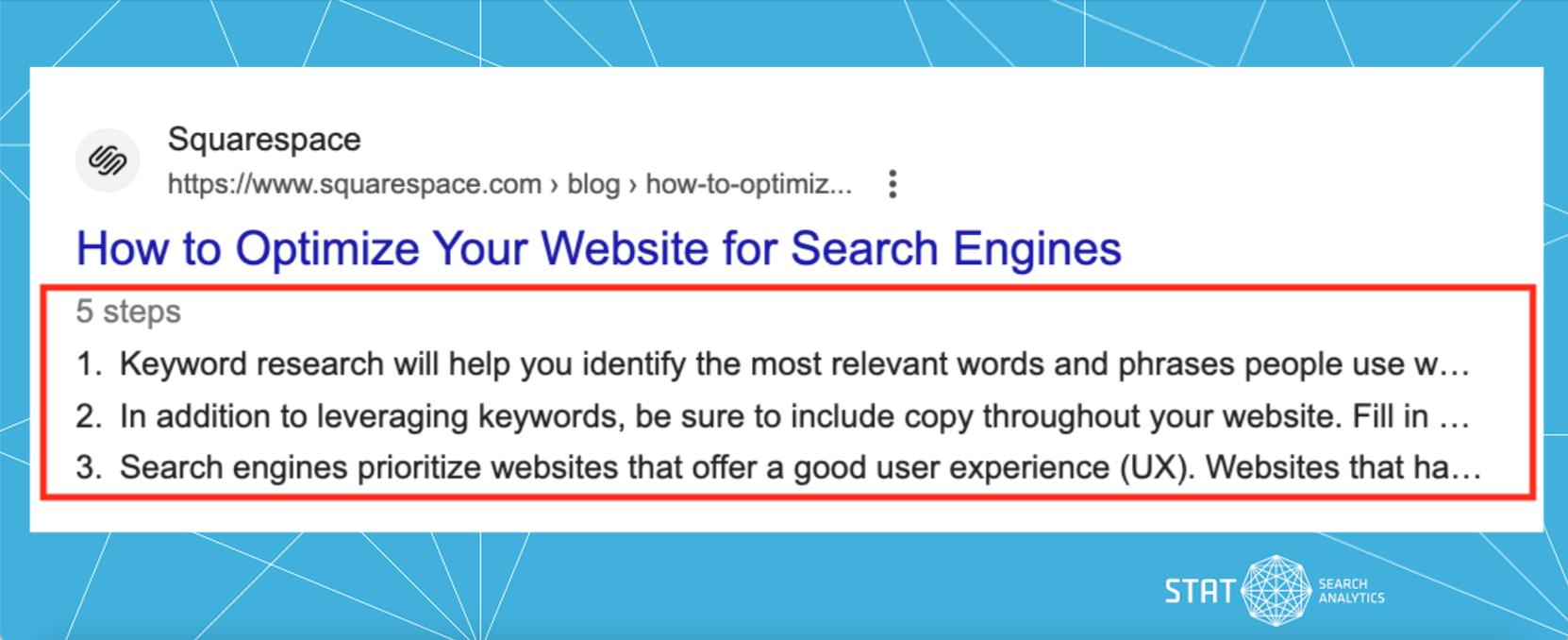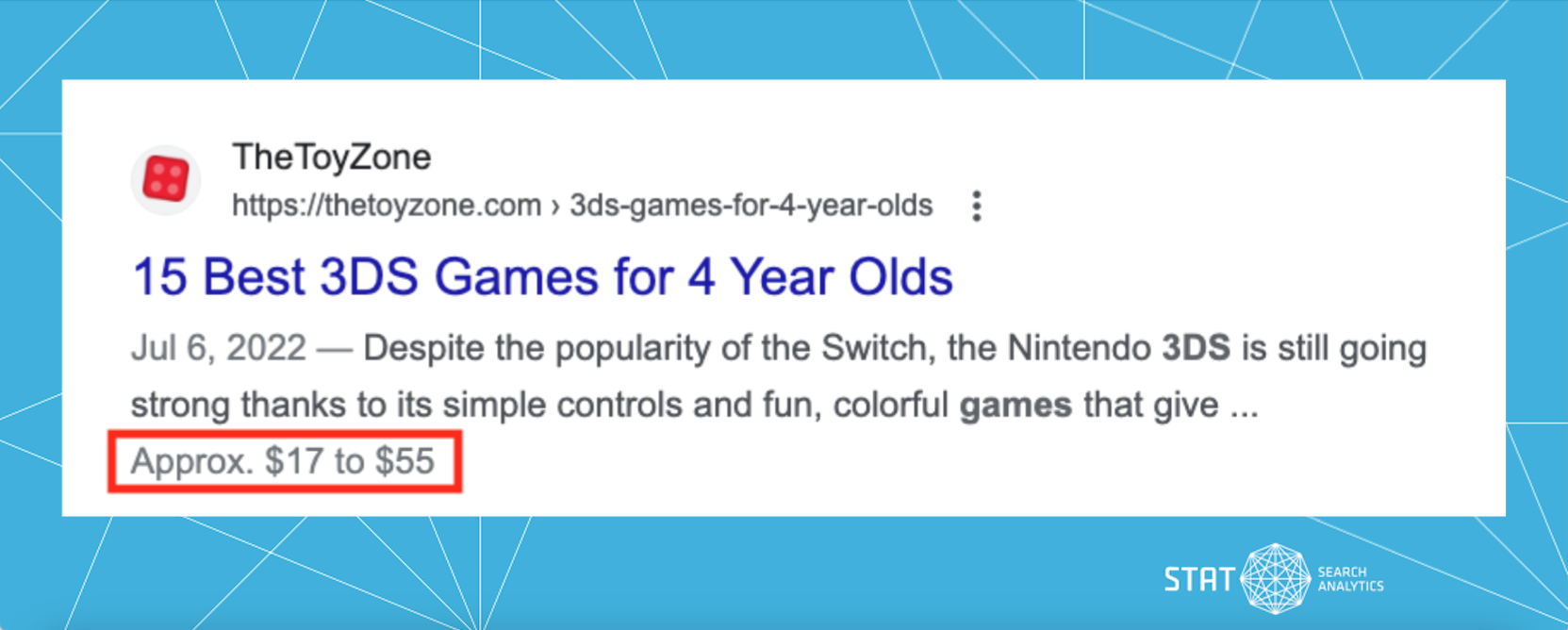Surface rich results to increase CTR and maximize the potential of your organic rankings.
When it comes to SEO, winning high organic rankings comes to mind as the most obvious end goal — but that’s not all there is to succeeding in search.
While several studies have shown that the biggest impact to organic click-through rates comes from rankings, you still need to stand out amongst a sea of other results — and that’s where rich snippets come in.
And seeing as we recently took a deep dive into SERP features, we thought their not-so-distant search relatives deserved equal attention. So, without further ado, it’s time to sharpen your technical SEO skills and get up close and personal with our good ol’ pals: rich snippets.
We’ll take a look at:
- The difference between rich snippets and SERP features
- Why rich snippets are too valuable to overlook
- How to optimize for rich snippets
- A closer look at five rich snippets:
- Some final words on optimization & tracking
Rich snippets vs. SERP features — what’s the difference?
While exact terminology can vary depending on who you ask, for our purposes, we’re drawing a line between SERP features and rich snippets (we’re also looking at making this distinction in classification in the STAT app down the road, but let’s not get ahead of ourselves).
And while Google has shifted in favor of the term rich results, we feel like the term snippet still more accurately represents the particular subgroup of results we’re talking about here, so we’re not quite ready to ditch the snippet label entirely, just yet.
We’re defining rich snippets as any kind of embellishment to a traditional blue-link search result that can more easily be surfaced by adding the required structured data to your site.
SERP feature, on the other hand, is a label we’re reserving for the more “old school” kind of features (like featured snippets, knowledge graphs, and local packs). These largely go beyond the typical SERP footprint of an organic link and meta description format and are more at the whim of Google to dole out.
Rich snippet or SERP feature?
Though a debatable topic, we’re bucketing rich snippets and SERP features into separate categories.
Why rich snippets are too valuable to overlook
The primary value in surfacing these additional bells and whistles is the enhanced visual presentation of your result on the SERP. Not only do rich snippets make your results look more appealing to searchers, they also expand your result to take up more valuable real estate on the SERP, which gives you increased organic visibility.
Taken together, this creates a more compelling and authoritative search result that stands out from the pack of plain old snippetless ones, which can lead to a higher click-through rate and increased traffic (though of course there are always a caveat or two when it comes to SEO, which we’ll get to shortly). We touch a bit on this impact and more in our Understanding & improving your organic click-through rate (CTR) post.
It also turns out that laying the very foundation on your site for rich snippets is a win on another front. Not only will your pages be eligible for rich results, but adding schema markup and structured data to your site helps Google better understand and parse your content across the board.
So, while rich snippets are not a ranking factor in their own right, it behooves any SEO hoping to rank well to get this markup added to their site.
The bottom line is that rich snippets provide a golden opportunity for SEOs to make the most out of their hard-won rankings.
One of these things is not like the other
Even though it is ranked below the other, our money’s on the result with the rich snippet getting the most clicks.
How to optimize for rich snippets
If you’re looking to kick back and live the lavish life, backstroking through your amassed pool of rich results like Scrooge McDuck, you’re going to need to dip your toe into the sometimes intimidating waters of technical SEO first.
Implementing the aforementioned structured data into your pages more specifically involves adding code on the back end of your site. By doing so, you can explicitly label and identify key elements of your content, clearly defining it and making it more readily discoverable for Google.
While there are a few different formats for this structured data, such as Microdata or RDFa, Google recommends using JSON-LD markup as it is generally the easiest to implement. It involves adding your structured data to the <head> tag as opposed to tweaking the HTML throughout the content of your page which can prove to be more time-consuming and prone to error, so that’s the format we’ll focus on too. And if you want to bypass editing the tag code directly on the back end, Google Tag Manager is always an option.
As a foundational rule, be sure to adhere to Google’s structured data guidelines — familiarize yourself and apply these general principles, keeping them in mind for any of your rich snippet optimization endeavours.
When you’re ready to take the plunge, be sure to utilize Google’s own Structured Markup Helper tool to generate the structured data you need to add to the backend of your site. Then make sure everything looks correct and test your structured data with the Rich Results testing tool.
And for those looking to get rich quick, the rich snippets game can entail a bit of delayed gratification. The crawling and indexing by Google and the appearance of new rich results on the SERP can take up to several weeks after actually implementing the changes to your site.
While there are a plethora of opportunities for surfacing different kinds of rich results, we’re going to hold the magnifying glass up and examine five more closely: ratings, recipes, FAQ, how-to, and pricing.
Let’s get to it!
Ratings
Social proof carries a lot of weight, and when looking to make a purchase or choose a service provider, it’s become standard consumer practice to consult online reviews and factor in the experiences shared by previous customers of a business.
Having a strong rating show up is not only important from a brand reputation standpoint, but it provides a compelling (and familiar) visual cue to searchers when they see a high star rating associated with your result.
Ratings can help boost searcher confidence in your result
Surfacing ratings as part of your rich organic result can help establish your authority as a reputable and trustworthy business.
Ratings | JSON-LD example
<script type=”application/ld+json”>
{
“@context”: “https://schema.org/”,
“@type”: “Product”,
…
“review”: {
“@type”: “Review”,
“reviewRating”: {
“@type”: “Rating”,
“ratingValue”: “5”,
“bestRating”: “5”
},
“aggregateRating”: {
“@type”: “AggregateRating”,
“ratingValue”: “5.0”,
“reviewCount”: “65”
}
Recipes
This tasty rich snippet can appear in a variety of formats, including a carousel, and enables you to add important additional parameters directly onto your search result, such as ingredients, preparation, and cooking time.
A short and sweet recipe for success
Recipe rich results can take a variety of formats and can provide vital information to help searchers choose your result (like preparation time).
While this can be said for any rich result they can be enabled for, it’s worth noting that images can be especially important in enticing clicks for recipe results. Just Google a few quick recipes and you’ll see that images are pretty much a brass tacks requirement (and you’ll stand out for the wrong reasons if you’re conspicuously missing one). So add high quality images into your rich results whenever you can.
Implementing this kind of code will help make your results eligible for enhanced Recipe rich results:
Recipes | JSON-LD example
<script type=”application/ld+json”>
{
“@context”: “https://schema.org/”,
“@type”: “Recipe”,
…
},
“datePublished”: “2023-04-14”,
“description”: “A delectable key lime pie — perfect for parties and entertaining.”,
“prepTime”: “PT15M”,
“cookTime”: “PT25M”,
“totalTime”: “PT40M”,
“keywords”: “cake for a party, key lime”,
“recipeYield”: “8”,
“recipeCategory”: “Dessert”,
“nutrition”: {
“@type”: “NutritionInformation”,
“calories”: “430 calories”
},
“recipeIngredient”: [
“6 limes”,
“list out your ingredients here”,
…
],
FAQ
Frequently Asked Questions snippets provide a unique opportunity to try to get ahead of your searchers by providing answers to anticipated questions.
You could potentially avoid a user heading back to the search bar and typing in a separate query by providing FAQ rich results to address their concerns, help eliminate blockers, and cover relevant adjacent topics.
There’s no doubt FAQs lead to a more prominent presence on the SERP. The caveat here is that if searchers can get everything they need right on the SERP, they may not actually click through to your site, so “success” here can be a delicate balance that will depend on your particular situation.
Optimizations for all rich results (and FAQs, in particular) should be tested and measured to determine the impact and weigh the pros and cons depending on your ultimate goals.
FAQs give searchers answers right on the SERP
FAQs can be a tricky snippet. You could help overcome customer objections preemptively — the question is, could this potentially discourage clicks on your result?
To opt in for the best chance of enhancing your results with FAQ, you’ll want to implement structured data similar to the following to your site:
How-to
If you’re providing step-by-step instructions, you can explicitly signal to Google (and the searcher) that your content is a “how-to” with this rich result type.
It's as easy as 1-2-3
Helpful how-to snippets spell out step-by-step instructions for searchers.
Laying out top of funnel instructions like this can be a good way to capture a searcher’s attention and raise awareness of your product or solution. After providing a solid, trustworthy answer, your reader may be primed and ready to explore other content on your site or take you up on a service offering.
Like FAQs, testing is important here to see the impact of how-to results as a searcher could forgo clicking on your result altogether if they can get everything they need right on the SERP.
Add markup similar to this example to ensure your content is eligible for the How-to rich result:
Price
Essential for any self-serve eCommerce website, is pricing. Not only can you highlight when a promotional offer is on, this added snippet can help searchers quickly hone in on products and solutions that are within their budget.
If your pricing is a competitive advantage for your business, you’ll definitely want to lean into surfacing this right on the SERP. On the other side of the coin, if you’re dealing in a space with premium pricing, you may be able to weed out unqualified traffic as searchers self-select out before clicking through to your site, resulting in higher quality traffic and an increased overall conversion rate from users that land on your page.
The price is right
Seeing a range within a customer’s budget could encourage a click.
If you’re looking to surface pricing rich snippets on your results, you’ll be looking to implement something similar to this Product structured data:
The SERPs are rich with opportunity
And there we have it! We’re hoping this has whet your rich snippets appetite — and while we’ve just scratched the surface, the opportunities for expanding your organic visibility with structured data are many.
After you’ve researched which rich result types are up for grabs, identified the ones that tie most directly with your site content and business goals, and implemented the required structured data, you’ll want to keep an eye on the impact of your changes.
Thankfully, there are a number of helpful tools to monitor the impact of your optimizations. Google Search Console will track the occurrence of valid rich results for your site and will provide error and warning messages for you to action specific fixes. STAT also tracks the appearance and ownership of all of the rich results covered in this post (and more!) in the SERP features tab so you can keep track of performance over time.
Hopefully you’re feeling more prepared to step out and conquer the wide world of rich snippets — happy optimizing!
